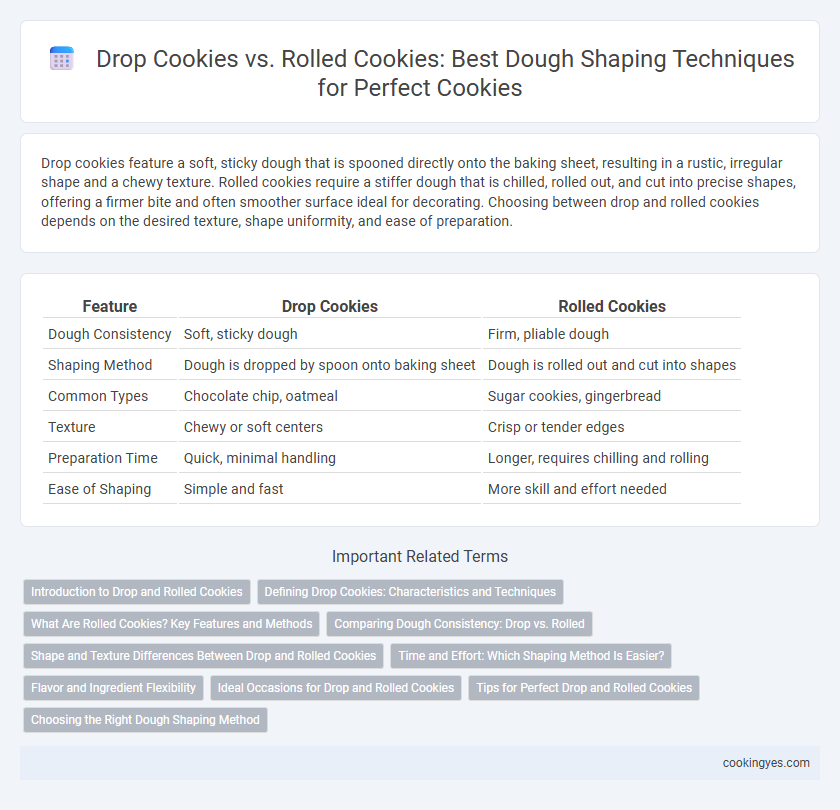Drop cookies feature a soft, sticky dough that is spooned directly onto the baking sheet, resulting in a rustic, irregular shape and a chewy texture. Rolled cookies require a stiffer dough that is chilled, rolled out, and cut into precise shapes, offering a firmer bite and often smoother surface ideal for decorating. Choosing between drop and rolled cookies depends on the desired texture, shape uniformity, and ease of preparation.
Table of Comparison
| Feature | Drop Cookies | Rolled Cookies |
|---|---|---|
| Dough Consistency | Soft, sticky dough | Firm, pliable dough |
| Shaping Method | Dough is dropped by spoon onto baking sheet | Dough is rolled out and cut into shapes |
| Common Types | Chocolate chip, oatmeal | Sugar cookies, gingerbread |
| Texture | Chewy or soft centers | Crisp or tender edges |
| Preparation Time | Quick, minimal handling | Longer, requires chilling and rolling |
| Ease of Shaping | Simple and fast | More skill and effort needed |
Introduction to Drop and Rolled Cookies
Drop cookies feature a soft dough that is dropped onto baking sheets in spoonfuls, resulting in irregular shapes and a chewy texture. Rolled cookies require a firmer dough that is rolled out and cut into precise shapes, offering a uniform appearance and often a crisp bite. Both methods influence the final cookie's texture and presentation, making them essential techniques in cookie baking.
Defining Drop Cookies: Characteristics and Techniques
Drop cookies are characterized by their soft, chewy texture and irregular shapes formed by spooning dough directly onto a baking sheet without rolling. Techniques for drop cookies involve using a thick, moist dough that spreads and flattens during baking, resulting in a tender crumb. Common examples include chocolate chip and oatmeal cookies, where minimal handling preserves moisture and creates a rustic appearance.
What Are Rolled Cookies? Key Features and Methods
Rolled cookies are shaped from dough that is flattened with a rolling pin and cut into shapes using cookie cutters, allowing for uniform thickness and intricate designs. Key features include a smooth, consistent texture and the ability to decorate precisely after baking, often seen in sugar cookies and gingerbread. The method involves chilling the dough to prevent sticking, rolling it evenly on a floured surface, and carefully transferring shapes to a baking sheet.
Comparing Dough Consistency: Drop vs. Rolled
Drop cookie dough is typically softer and more moist, allowing it to be easily spooned or dropped onto baking sheets without extensive handling, resulting in a more tender texture. Rolled cookie dough is stiffer and more elastic, requiring chilling and rolling out to achieve uniform thickness, which provides a crispier, more structured bite. The moisture and fat content differences in each dough type directly influence their shaping method and final cookie texture.
Shape and Texture Differences Between Drop and Rolled Cookies
Drop cookies have a more irregular, rustic shape because their dough is soft and spooned directly onto the baking sheet, resulting in a chewy or cakey texture with crispy edges. Rolled cookies require chilled dough that is rolled out and cut into precise shapes, producing a uniform, flat appearance with a firm, crisp texture ideal for decorative icing. The dough composition for rolled cookies is typically stiffer, which helps maintain the defined shape and a tender bite after baking.
Time and Effort: Which Shaping Method Is Easier?
Drop cookies require less time and effort as the dough is simply scooped and dropped onto the baking sheet, eliminating the need for chilling or rolling. Rolled cookies demand more preparation, including chilling the dough to achieve the right consistency and using a rolling pin and cutters to shape each cookie precisely. For bakers seeking convenience and speed, drop cookies offer a straightforward approach, whereas rolled cookies provide more control over cookie thickness and uniformity at the cost of additional time.
Flavor and Ingredient Flexibility
Drop cookies offer greater ingredient flexibility, easily accommodating mix-ins like nuts, chocolate chips, or dried fruit, which enhances flavor complexity. Rolled cookies, shaped by cutting dough, typically have a denser texture that allows sturdier spices and rich flavorings like ginger or cinnamon to hold well without spreading. Both methods influence the final taste profile by controlling dough moisture and mix-in distribution, impacting flavor intensity and texture consistency.
Ideal Occasions for Drop and Rolled Cookies
Drop cookies, known for their casual, rustic appearance, are ideal for everyday treats, school snacks, and informal gatherings where quick preparation and a soft texture are desired. Rolled cookies, with their smooth surface and ability to hold intricate designs, are perfect for festive occasions such as holidays, birthdays, and special events that require decorative shapes and a firmer bite. Choosing between drop and rolled cookies depends on the event's formality and the desired presentation.
Tips for Perfect Drop and Rolled Cookies
For perfect drop cookies, use a well-chilled dough to prevent excessive spreading during baking and employ a consistent cookie scoop for uniform size and even cooking. Rolled cookies require precise dough thickness, achieved by rolling between parchment paper or lightly floured surfaces to avoid sticking, with frequent dough chilling to maintain shape. Baking time adjustments based on cookie thickness ensure optimal texture, while minimizing overmixing preserves tender crumb for both drop and rolled varieties.
Choosing the Right Dough Shaping Method
Drop cookies require softer, wetter dough that is spooned directly onto the baking sheet, promoting quick preparation and yielding a moist, textured bite. Rolled cookies demand a firm, less sticky dough that is chilled and rolled out before cutting, enabling precise shapes and uniform thickness for even baking. Selecting between drop and rolled cookies depends on the desired texture, shape precision, and time available for dough preparation.
Drop cookies vs Rolled cookies for dough shaping Infographic

 cookingyes.com
cookingyes.com